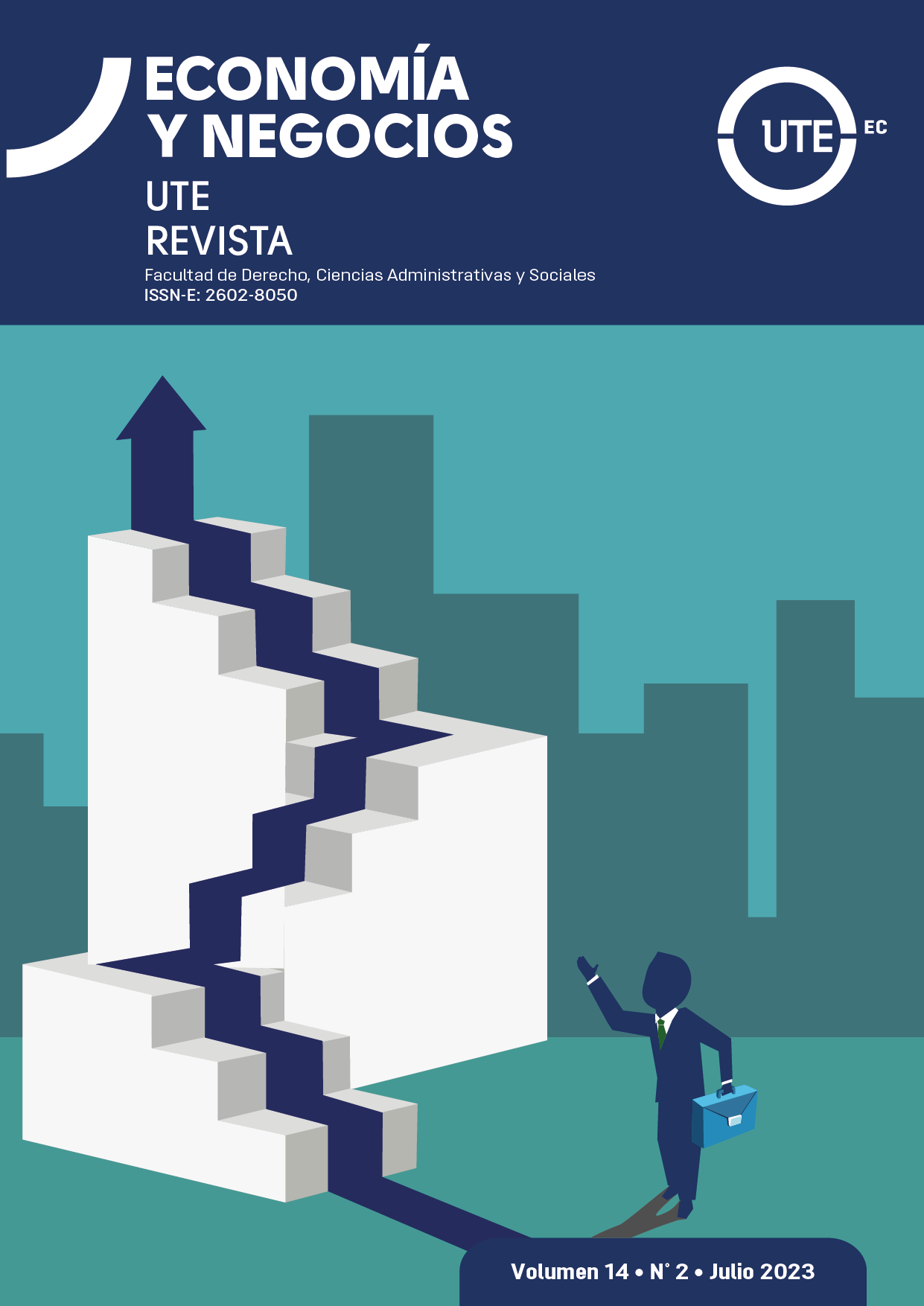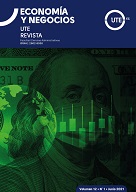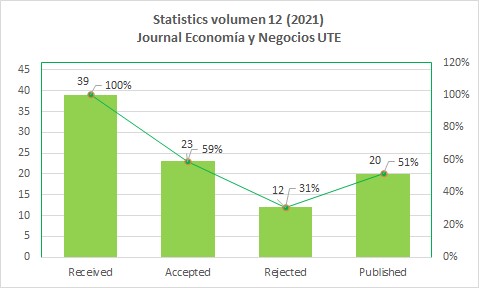Aproximación a la Estructuración de Pequeñas y Medianas Empresas: Un Recorrido Teórico
DOI:
https://doi.org/10.29019/eyn.v14i2.1147Palabras clave:
Diseño organizacional, Pymes, Estructuración de organizaciones, Enfoque por procesos, Organización de empresasResumen
El artículo ofrece una aproximación teórica a la estructuración de pequeñas y medianas empresas (pymes), centrándose en los elementos clave que influyen en su diseño organizativo y en su éxito a largo plazo. El texto examina los factores externos que afectan a la estructuración de las pymes, como el entorno económico, la industria y los mercados en los que operan. Asimismo, se exploran los elementos internos de la estructuración, incluyendo la definición de la misión, visión y valores de la empresa, así como la elaboración de una estructura organizativa eficiente. Se discuten diferentes enfoques de estructuración, como la estructura funcional, matricial y basada en equipos, y se destacan las ventajas y desafíos asociados con cada una de ellas. Además, se aborda el papel del liderazgo en la estructuración de las pymes y se examinan las habilidades y competencias necesarias para liderar con éxito estas organizaciones en constante cambio. Finalmente, se enfatiza la importancia de la flexibilidad y la capacidad de adaptación en la estructuración de las pymes, ya que estos elementos les permiten responder de manera ágil a los desafíos y oportunidades del entorno empresarial. En conclusión, este recorrido teórico por la estructuración de las pymes destaca la importancia de un enfoque estratégico y adaptativo para lograr su desarrollo sostenible y competitividad en el mercado. El artículo proporciona un marco conceptual útil para investigadores, emprendedores y directivos interesados en comprender y mejorar la estructura organizativa de las pymes.
Descargas
Citas
Abchuk, V. A. (2002). Management. Union.
Afxentiou, G. (2019). Restructured organizational design: The secret sauce in a food manufacturer’s recipe for growth. Global Business and Organizational Excellence, 38(5), 27-32. https://doi.org/10.1002/joe.21948
Aharoni, Y. (1966). The Foreign Investment Decision Process. Harvard University Press.
Ambroise, L., Prim-Allaz, I., Teyssier, C., &y Peillon, S. (2018). The environment-strategy-structure fit and performance of industrial servitized SMEs. Journal of Service Management, 29(2), 301-328. https://doi.org/10.1108/JOSM-10-2016-0276
Barki, H., & Pinsonneault, A. (2005). A model of organizational integration, implementation effort, and performance. Organization Science, 16(2), 165-179. https://bit.ly/3WuAtRj
Bjerreskov Dinitzen, H., & Krogh Jensen, L. (2010). Organisational Theory-a practical approach. Hans Reitzels Forlag.
Burns, T., & Stalker, G. M. (1961). The management of innovation. Tavistock Publications.
Cain, L., Moreo, P. J., & Hanin Nazlan, N. (2018). Hotel managers' job satisfaction: Is control more important than structure? Journal of Human Resources in Hospitality and Tourism, 17(4), 465-481.
Clauset, A., Moore, C., & Newman, M. E. J. (2008). Hierarchical structure and the prediction of missing links in networks. Nature, 453(7191), 98-101. https://doi.org/10.1038/nature06830
Cloke, K., & Goldsmith, J. (2002). The end of management and the rise of organizational democracy. Jossey-Bass Inc.
Courtright, J.A., Fairhurst, G.T., & Rogers, L.E. (1989). Interaction patterns in organic and mechanistic systems. The Academy of Management Journal, 32(4), 773-802. https://doi.org/10.2307/256568
Chandler, A.D. (1962). Strategy and Structure: Chapters in the History of the American Industrial Enterprise. The MIT Press.
Chattopadhyay, S. (2019). Re-imagining organizations as ecosystems. Exploring the paradigm shifts necessary to move toward a living systems view of organizations. https://bit.ly/42PR0ld
Chia, R. (1997). Essai: Thirty years on: From organizational structures to the organization of thought. Organization Studies, 18(4), 685-707. https://doi.org/10.1177/017084069701800406
Chiavenato, I. (2001). Administración. Teoría, proceso y práctica. (3ra ed.). McGraw Hill Interamericana.
Chin, L.G. (2016). Unequal egalitarianism: Does organizational structure create different perceptions of male versus female leadership abilities? Gender in Management, 31(1), 19-42. https://doi.org/10.1108/GM-10-2014-0093
Dischner, S. (2015). Organizational structure, organizational form, and counterproductive work behavior: A competitive test of the bureaucratic and post-bureaucratic views. Scandinavian Journal of Management, 31(4), 501-514. https://doi.org/10.1016/j.scaman.2015.10.002
Divakaran, A., Neilson, G. L., & Pandrangi, J. (2013). How to design a winning company. strategy+business, Autumn, (72), 1-14. https://bit.ly/3Onezxi
Doz, Y. (2016). Managing multinational operations: From organisational structures to mental structures and from operations to innovations. European Journal of International Management, 10(1), 10-24. https://doi.org/10.1504/EJIM.2016.073998
Du Gay, P. (2012). Exploitation, Exploration and exaltation: notes on a metaphysical (Re)turn to ‘One Best Way of Organizing’. En S. Vikkelsø, H. Mikael & S. André (eds.), Managing ‘Human Resources’ by Exploiting and Exploring People’s Potentials (Vol. 37, pp. 249-279). Emerald Group Publishing.
Ethiraj, S. K., & Levinthal, D. (2004). Bounded rationality and the search for organizational architecture: an evolutionary perspective on the design of organizations and their evolvability. Administrative Science Quarterly, 49, 404-437. https://doi.org/10.2307/4131
Fleischman, F. (2017). Questioning Kaufman: how cross-level political coalitions interact with organizational structure. Public Administration Review, 77(5), 743-751. https://doi.org/doi:10.1111/puar.12753
Freeman, C. (1969). T. Burns and G. M. Stalker. The Management of Innovation. The Economic Journal, 79(314), 403-405. https://doi.org/10.2307/2230196
Galbraith, J. R., & Lawler III, E. E. (1993). Organizing for the future: the new logic for managing complex organizations. (1st ed.). Jossey-Bass Inc.
Galván Sánchez, I., & Fernández Monroy, M. (2007). Los procesos dominantes en la formación de estrategias de las organizaciones virtuales. Una aproximación teórica. Paper presentado en el XX Congreso anual de AEDEM, Madrid.
Gentile-Lüdecke, S., Torres de Oliveira, R., & Paul, J. (2019). Does organizational structure facilitate inbound and outbound open innovation in SMEs? Small Business Economics, 55, 1091-1112. https://doi.org/10.1007/s11187-019-00175-4
Gray, E.R., & Smeltzer, L.R. (1989). Management: The Competitive Edge. Maxwell Macmillan International Editions.
Grobelnik, M., Mladenic, D., & Fortuna, B. (2009). Semantic technology for capturing communication inside an organization. IEEE Internet Computing, 13(4), 59-67. https://doi.org/10.1109/MIC.2009.88
Gurianova, E., & Mechtcheriakova, S. (2015). Design of organizational structures of management according to strategy of development of the enterprises. Procedia Economics and Finance, 24, 395-401. https://doi.org/10.1016/S2212-5671(15)00695-4
He, Y., Sun, H., & Chen, Y. (2016). How cross-functional management influences new product development: a socio-technical perspective. Technology Analysis & Strategic Management, 28(9), 1095-1107. https://doi.org/10.1080/09537325.2016.1181743
Henderson, S.S., & Smith-King, E.J. (2015). Sectoral decision making: Structures, processes and trust. Management Decision, 53(7), 1545-1559. https://doi.org/10.1108/MD-04-2015-0128
Holck, L. (2018). Unequal by structure: Exploring the structural embeddedness of organizational diversity. Organization, 25(2), 242-259. https://doi.org/10.1177/1350508417721337
Hopej-Kamińska, M., Zgrzywa-Ziemak, A., Hopej, M., Kamiński, R., & Martan, J. (2015). Simplicity as a feature of an organizational structure. Argumenta Oeconomica, 34(1), 259-276. https://doi.org/10.15611/aoe.2015.1.10
Jaakkola, E., & Hallin, A. (2018). Organizational structures for new service development. Journal of Product Innovation Management, 35(2), 280-297. https://doi.org/10.1111/jpim.12399
Jia, F., Orzes, G., Sartor, M., & Nassimbeni, G. (2017). Global sourcing strategy and structure: Towards a conceptual framework. International Journal of Operations and Production Management, 37(7), 1-49. https://doi.org/10.1108/IJOPM-09-2015-0549
Johanson, J., & Vahlne, J.E. (1977). The internationalization process of the firm—A model of knowledge development and increasing foreign market commitments. Journal of International Business Studies, 8(1), 23-32. https://doi.org/10.1057/palgrave.jibs.8490676
Keidel, R. W. (1995). Seeing organizational patterns: a new theory and language of organizational design. Berrett-Koehler Publishers, Inc.
Knoche, H., & Castrogiovanni, G.J. (2015). The effects of informal social structures: a cognition-structure-action approach. Organization Management Journal, 12(3), 139-152. https://doi.org/10.1080/15416518.2015.1015113
Koontz, H., & Weihrich, H. (2013). Elementos de Administración. Un enfoque internacional y de innovación. (8va ed.). McGraw-Hill/ Interamericana Editores.
Koontz, H., Weihrich, H., & Cannice, M. (2012). Administración. Una perspectiva global y empresarial. (14 ed.). McGraw-Hill/ Interamericana Editores.
Král, P., & Králová, V. (2016). Approaches to changing organizational structure: The effect of drivers and communication. Journal of Business Research, 69(11), 5169-5174. https://doi.org/10.1016/j.jbusres.2016.04.099
Lægaard, J., & Bindslev, M. (2006). Organizational Theory. https://bit.ly/435Df2a
Lawrence, P.R., & Lorsch, J.W. (1986). Organization and Environment: Managing Differentiation and Integration. (Revised edition ed.). Harvard Business Review Press.
Lester, E. I. A. (2017). Chapter 9 - Organization Structures. En E. I. A. Lester (ed.), Project Management, Planning and Control, (Seventh Edition) (pp. 43-45). Butterworth-Heinemann.
Liao, C., Chuang, S.H., & To, P.L. (2011). How knowledge management mediates the relationship between environment and organizational structure. Journal of Business Research, 64(7), 728-736. https://doi.org/10.1016/j.jbusres.2010.08.001
Liu, Y., Wei, J., Zhou, D., Ying, Y., & Huo, B. (2016). The alignment of service architecture and organizational structure. Service Industries Journal, 36(9-10), 396-415. https://doi.org/10.1080/02642069.2016.1248417
Mackenzie, K. D. (2000). Virtual positions, processes, and organizations. Paper presentado en el Seminario de Planificación 2000 de la Academia Coreana de Administración Pública, Seúl.
Marín Idárraga, D.A., & Cuartas Marín, J.C. (2014). Teorías del análisis y diseño organizacional: una revisión a los postulados contingentes y de la co-alineación estratégica. Revista Facultad de Ciencias Económicas: Investigación y Reflexión, XXII(1), 153-168. https://bit.ly/3IEg86p
Marx, T. G. (2016). The impacts of business strategy on organizational structure. Journal of Management History, 22(3), 249-268. https://doi.org/10.1108/JMH-01-2016-0003
Mintzberg, H. (1979). The Structuring of Organizations. Prentice Hall.
Mintzberg, H. (1991). Diseño de organizaciones inteligentes. (2da ed.). Librería "El Ateneo" Editorial.
Miralbell Izard, O. (1999). Visión estratégica de las organizaciones virtuales en el turismo. Aprovechamiento de las tecnologías de la comunicación y la información para la competitividad de la empresas turísticas. Paper presentado en TuriTec '99: I Congreso Nacional Turismo y Tecnologías de la Información y las Comunicaciones: Nuevas Tecnologías y Calidad, Madrid.
Modenov, A.K., & Vlasov, M. P. (2018). Organizational structure and economic security of an enterprise. Espacios, 39(39), 22. https://bit.ly/42ZJlko
Mowshowitz, A. (1994). Virtual organization: A vision of management in the information age. The Information Society, 10(4), 267-288. https://doi.org/10.1080/01972243.1994.9960172
Negrón-González, A. M., Gemar-Castillo, G., & Noda-Hernández, M. E. (2021). Modelo de Gestión de Costos Ocultos para la Mejora Continua de los Recursos Humanos. Economía y Negocios, 12(2), 01–17. https://doi.org/10.29019/eyn.v12i2.946
Nelson, R., & Winter, S. (1982). An evolutionary theory of economic change. Harvard University Press.
Nickerson, J.A., & Zenger, T.R. (2002). Being efficiently fickle: a dynamic theory of organizational choice. Organization Science, 13(5), 547-566. https://doi.org/10.1287/orsc.13.5.547.7815
Pérez-Campdesuñer, R., Marrero-Arias, R., & De Miguel-Guzmán, M. (2021). Variables Determinantes de las Prácticas de Gestión de Recursos Humanos en Micro y Pequeñas Empresas. Economía y Negocios, 12(2), 18–31. https://doi.org/10.29019/eyn.v12i2.944
Pettigrew, A., Massini, S., & Numagami, T. (2000). Innovative forms of organising in Europe and Japan. European Management Journal, 18(3), 259-273. https://doi.org/10.1016/S0263-2373(00)00008-6
Poli, S. (2018). Chapter 4 - Organizational Structures. En J. Andersen, K. Toom, S. Poli & P. F. Miller (eds.), Research Management, (pp. 89-107). Academic Press.
Qiu, J., & Lin, Z. (2011). A framework for exploring organizational structure in dynamic social networks. Decision Support Systems, 51(4), 760-771. https://doi.org/10.1016/j.dss.2011.01.011
Real Fernández, J.C. (1999). El diseño de la estructura organizativa en las organizaciones no gubernamentales para el desarrollo (ONGD) españolas. Una aproximación contingente. Paper presentado en La gestión de la diversidad: XIII Congreso Nacional, IX Congreso Hispano-Francés, Logroño, La Rioja.
Reyes-Ramírez, L. A., Leyva-del Toro, C., Pérez-Campdesuñer, R., & Sánchez-Rodríguez, A. (2022). Variables de la responsabilidad social corporativa. Un modelo de ecuaciones estructurales. Retos Revista de Ciencias de la Administración y Economía, 12(24), 286-305. https://doi.org/10.17163/ret.n24.2022.06
Robbins, S.P., & Coulter, M. (2014). Administración. (12da ed.). Pearson Educación de México.
Robbins, S.P., & Judge, T.A. (2013). Comportamiento organizacional. (15va ed.). Pearson Educación de México.
Roth, A.V., & Menor, L.J. (2003). Insights into service operations management: a research agenda. Production and Operations Management, 12(2), 145-164. https://doi.org/10.1111/j.1937-5956.2003.tb00498.x
Rudzki, R., & Trent, R. (2011). Next level supply management excellence: Your straight to the bottom-line roadmap. J. Ross Publishing.
Scott, R. W. (2002). Organizations: Rational, natural and open systems (5th ed.). Prentice Hall.
Sherman, J.D., Berkowitz, D., & Souder, W.E. (2005). New product development performance and the interaction of cross-functional integration and knowledge management. Journal of Product Innovation Management, 22(5), 399-411. https://doi.org/10.1111/j.1540-5885.2005.00137.x
Smet, A. D., Kleinman, S., & Weerda, K. (2019). The helix organization. McKinsey Quarterly, October, 1-10. https://bit.ly/437OZ3v
Song, M., & van der Aalst, W. M. P. (2008). Towards comprehensive support for organizational mining. Decision Support Systems, 46(1), 300-317. https://doi.org/10.1016/j.dss.2008.07.002
Stoner, J.A.F., Freeman, R.E., & Gilbert, D.R. (1996). Administración. (6ta ed.). Prentice Hall Hispanoamericana S.A.
Strategor. (1995). Estrategia, estructura, decisión, identidad. Política general de la empresa. Masson. S.A.
Su, Z., Chen, J., & Wang, D. (2019). Organisational structure and managerial innovation: the mediating effect of cross-functional integration. Technology Analysis and Strategic Management, 31(3), 253-265. https://doi.org/10.1080/09537325.2018.1495324
Terrenina, I.V., Kostoglodov, D.D., Osadchaya, N.A., & Mikhailichenko, E.V. (2018). Principles and methods of efficient organization of vertically integrated structures in the agro-industrial sector. European Research Studies Journal, 21, 496-505. https://doi.org/10.11214/thalassinos.21.05.047
Valaei, N. (2017). Organizational structure, sense making activities and SMEs’ competitiveness: An application of confirmatory tetrad analysis-partial least squares (CTA-PLS). VINE Journal of Information and Knowledge Management Systems, 47(1), 16-41. https://doi.org/10.1108/VJIKMS-04-2016-0015
Vantrappen, H., & Wirtz, F. (2018). A smarter process for managing and explaining organization design change. Strategy and Leadership, 46(5), 36-43. https://doi.org/10.1108/SL-06-2018-0057
Vikkelsø, S. (2015). Core task and organizational reality. Journal of Cultural Economy, 8(4), 418-438. https://doi.org/10.1080/17530350.2014.954596
Volberda, H. W. (1996). Toward the Flexible Form: How to Remain Vital in Hypercompetitive Environments. Organization Science, 7(4), 359-374. https://doi.org/10.1287/orsc.7.4.359
Zakrzewska-Bielawska, A. (2016). Perceived mutual impact of strategy and organizational structure: Findings from the high-technology enterprises. Journal of Management and Organization, 22(5), 599-622. https://doi.org/10.1017/jmo.2015.55
Descargas
Publicado
Cómo citar
Número
Sección
Categorías
Licencia
Derechos de autor 2023 Los Autores

Esta obra está bajo una licencia internacional Creative Commons Atribución 4.0.
Los artículos e investigaciones publicadas por la Universidad UTE, se realizan en régimen de Acceso Abierto [Open Access] en formato electrónico. Al enviar un artículo a cualquiera de las revistas científicas de la Universidad UTE, el o los autores aceptan estas condiciones.
La UTE aplica la licencia Creative Commons Attribution (CC-BY) a los artículos de sus revistas científicas. En virtud de esta licencia de acceso abierto, como autor usted acuerda que cualquier persona puede reutilizar su artículo en su totalidad o en parte para cualquier propósito, de forma gratuita, incluso para fines comerciales. Cualquiera puede copiar, distribuir o reutilizar el contenido siempre y cuando el autor y la fuente original estén correctamente citados. Esto facilita la libertad de reutilización y también asegura que el contenido pueda ser extraído sin barreras para necesidades de investigación.
Licencia Creative Commons Atribución 4.0 Internacional
La Revista Economía y Negocios está distribuida bajo una
Creative Commons Attribution 4.0 International (CC BY 4.0).

Además, la Revista Economía y Negocios garantiza y declara que los autores conservan siempre todos los derechos de autor y de publicación de sus obras originales sin restricciones [© Los Autores]. El reconocimiento (BY) permite cualquier explotación de la obra, incluyendo una finalidad comercial, así como la creación de obras derivadas, la distribución de las cuales también está permitida sin ninguna restricción.















